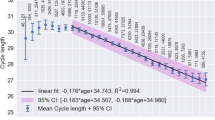Abstract
BACKGROUND: To investigate the impact of predominantly upper body fat localisation on the hormonal and metabolic profile in obese, infertile women. DESIGN: Prospective observational study of premenopausal women with obesity, infertility and menstrual dysfunction. SETTING: Department of Endocrinology and Reproduction of the University Hospital of Obstetrics and Gynaecology of Heidelberg. SUBJECTS: Eighteen women with android type obesity (waist-hip-ratio=WHR>0.85, group 1) and 22 women with gynoid type obesity (WHR≤0.85, group 2) in a group of 58 premenopausal obese women (median age 28 y) with infertility. Twenty-nine women took part in a weight reducing program lasting 32±14 (mean±s.d.) weeks. MEASUREMENTS: BMI, WHR and blood pressure. Plasma lipids and liver enzymes. Blood glucose, insulin, C-peptide and different steroid and pituitary hormones during oral glucose loading. RESULTS: In the total group of 58 obese women, WHR was directly correlated to plasma triglycerides, AST, ALT and cholesterol/HDL-cholesterol-ratio. WHR correlated inversely with HDL-cholesterol. Insulin resistance was greater with increasing WHR. Systolic blood pressure, glucose, insulin, C-peptide, triglycerides, cholesterol/HDL-cholesterol-ratio, aspartate (AST) and alanine aminotransferase (ALT) were significantly greater in group 1. Group 2 had greater HDL-cholesterol levels. One subject in group 1, five women in group 2 conceived spontaneously after weight reduction. CONCLUSIONS: Determination of the WHR is a simple measurement to identify obese patients who are at a greater risk of developing the metabolic syndrome. WHR is important in preventive medicine, as typical metabolic profiles are already present in young women before clinical manifestation. Women with android obesity seem to be more prone to develop menstrual irregularity and infertility. The hyperinsulinaemia may be the pathway.
This is a preview of subscription content, access via your institution
Access options
Subscribe to this journal
Receive 12 print issues and online access
$259.00 per year
only $21.58 per issue
Buy this article
- Purchase on Springer Link
- Instant access to full article PDF
Prices may be subject to local taxes which are calculated during checkout
Similar content being viewed by others
Author information
Authors and Affiliations
Rights and permissions
About this article
Cite this article
Hollmann, M., Runnebaum, B. & Gerhard, I. Impact of waist-hip-ratio and body-mass-index on hormonal and metabolic parameters in young, obese women. Int J Obes 21, 476–483 (1997). https://doi.org/10.1038/sj.ijo.0800433
Received:
Revised:
Accepted:
Issue Date:
DOI: https://doi.org/10.1038/sj.ijo.0800433
Keywords
This article is cited by
-
Relationship of breast volume, obesity and central obesity with different prognostic factors of breast cancer
Scientific Reports (2021)
-
Is body mass index associated with irregular menstruation: a questionnaire study?
BMC Women's Health (2020)
-
The impact of body size changes on recurrence risk depends on age and estrogen receptor status in primary breast cancer
Cancer Causes & Control (2019)
-
Serum leptin level and waist-to-hip ratio (WHR) predict the overall survival of metastatic breast cancer (MBC) patients treated with aromatase inhibitors (AIs)
Breast Cancer (2013)
-
Given breast cancer, does breast size matter? Data from a prospective breast cancer cohort
Cancer Causes & Control (2012)



